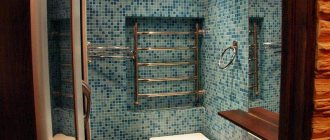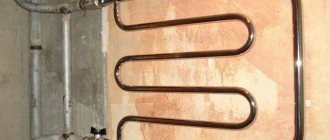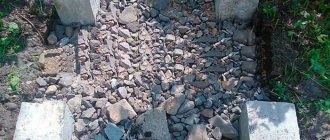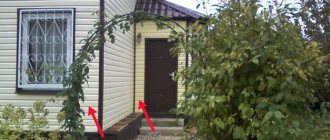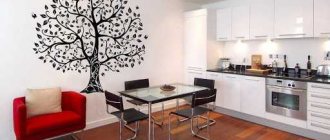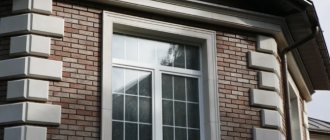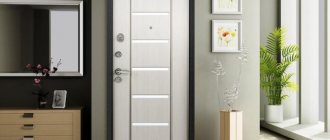The door threshold is designed to improve sound insulation and thermal insulation of the doorway. It is a cross beam located on the floor in the door frame, and the height of this device should not be more than 4 cm.
The floor plank serves to provide a smooth and visually attractive transition between rooms or from the street into the house. If the floor in adjacent rooms is located at different heights, then this element of the door structure does not need to be installed. It can be mounted on any floor covering. It will perfectly complement the interior design.
Types of thresholds and their functional purpose
According to the design features, there are flat, T-shaped, flexible or overhead thresholds with external or hidden installation.
Rice. 1. Threshold options
Based on the building materials used, you can purchase the following types of systems:
Rice. 4. Plastic threshold
Fig.5. Metal threshold
Wooden products can be made with your own hands, but they will not look like those made using specialized equipment. Brass thresholds will last forever, aluminum products are more affordable, and you can accentuate your attention with a polymer profile with a textured finish. Plastic thresholds are quite flexible; they hide various joint defects.
How to choose a threshold for an interior door
Nowadays, even professionals find it difficult to make their choice from the variety of door thresholds offered by different manufacturers. In addition to wood products, stores have many components, which need to be selected according to the following criteria:
It is necessary to choose the right type of threshold not only based on external attractiveness, but also on functional and quality indicators. You should also take into account the features of the room, the opening where the structure will be mounted. For example, for a bathroom you should choose a product made of moisture-resistant material.
Based on the conditions of use and the characteristics of the room, an ordinary, multi-level bar or guillotine threshold is distinguished. Multi-level types are used in places where there is a difference in coverage between different rooms, but a guillotine is not installed for every door .
Suitability of installation in the bathroom and toilet
Installing any threshold for rooms with high humidity is a rational solution, since if pipes or a washing machine are damaged, the thresholds will become protection against flooding of other rooms.
If you use a threshold as waterproofing in case of a possible water supply failure, then you need to install a stone version. To prevent humidity from increasing in the bathroom, you should install an electric fan in the ventilation duct or buy a box without a seal, leaving a gap of 4-5 mm between the threshold and the bottom end of the door.
Level difference
Brass and aluminum floor thresholds for different purposes are made from 3 types of profiles:
- flat (the upper side may have a convex shape);
- corner (transitional step, difference in the thickness of adjacent floorings);
- T-shaped (for installation at the joints of materials of different structures, for example, tiles/laminate/parquet).
Where the difference in levels forms a clearly defined step, an angular profile is installed to maintain the integrity of the edge and protect the legs.
Related article: What affects the heating rate of a water heater?
The structure for multi-level transitions can be prefabricated or solid (with a given angle of inclination and width of the closing surface).
Aluminum prefabricated thresholds are much more versatile in their application. They can be adjusted in the range of 3 – 15 mm.
Installation methods
Once the dimensions of the thresholds for interior wooden doors have been determined, installation work begins. The installation process of such a structure can be carried out using different methods.
Installation of a wooden threshold
When choosing wood, it is better to purchase a ready-made kit with characteristics corresponding to the parameters of the opening. Before installation, remove the old fasteners, clear the surface of debris, and level the concrete screed.
After determining the dimensions of the future structure, its height is calculated and grooves are made from the bottom of the side posts based on the measurements taken . After measuring the width of the box, the wood blank is cut, inserted into place and hammered through a special gasket.
The threshold should be drilled in several places so that the points are visible. After you remove the threshold, holes are made according to the marks on the concrete and fasteners (dowels) are hammered into them. Then the threshold is put in place, screwed with self-tapping screws and their caps are recessed into the strip. The holes are filled with putty.
When installing a wooden threshold in a toilet or bathroom, you need to ensure its height so that there is a gap of 4-5 mm between the panel and the strip for air flow into the bathroom and the efficiency of the supply and exhaust system.
External and internal methods of fastening door thresholds
The following installation methods are distinguished:
With the help of external fastening, the threshold is easier to fix, but the internal method will be preferable due to aesthetics. This applies to laminate products where a neat appearance is required.
Rice. 8. Threshold fastening diagram
Guillotine threshold - a useful novelty
Recently, anti-thresholds have become popular, which are traditionally placed at the bottom of the door, but can be mounted at the top of the opening. The structures are called guillotine or smart thresholds; they are required for sealing, increasing noise and thermal insulation of the door, protecting the room from smoke, wind and dust. These are versatile, durable and attractive devices.
They are a U-shaped profile made of aluminum, which is equipped on the hinge side with a starting device with a movable seal. The operating principle of the automatic threshold is as follows: when the sash is closed, the button is activated and the gap is closed by a seal. When opening the panel, the button goes down and does not interfere.
Rice. 9. Guillotine and its functioning
The insertion depth of the sill is 2 cm, so it cannot be used in hollow structures with small timber thickness.
Korovin Sergey Dmitrievich
Master of Architecture, graduated from Samara State University of Architecture and Civil Engineering. 11 years of experience in design and construction.
Source
What determines the size of entrance doors, their weight and thickness?
The dimensions of entrance doors are fixed and are taken into account during their installation and production, as well as during the construction of the opening. The main parameters are thickness, width, height and weight. Each of these values serves as an indicator of the quality of the door and its performance characteristics and resistance to burglary depend on how well it meets the state standard (GOST).
Door sizes according to GOST
GOST standards and requirements include information not only about linear parameters, but also information regarding the materials for manufacturing doors and the technique of installing them in the opening.
According to these standards, the width of the door leaf can be of 2 types (mm):
Since an entrance group made of canvas and a box is immediately purchased for the house, it is necessary to add 70 mm (the basic dimensions of the box) to the above parameters.
That is, the final result of the door width is 870 or 970 mm.
Standard height (mm):
- 2000 or 2300;
- 2070 or 2370 including the box.
Such dimensions allow you to easily pass through the entrance area, as well as carry large objects (furniture, equipment, etc.) without damaging the doorway.
Thanks to these provisions, standard entrance groups have a number of advantages:
- they are easy and quick to install; there is no need to build up or expand the opening, as can happen when installing non-standard blocks;
- they have a more affordable price than designs made to individual measurements;
- If the door leaf is damaged or defective, it can be replaced with a new one by selecting an analogue of the appropriate size; there is no need to replace the frame or repair the opening.
The use of structures of non-standard sizes is also permissible, but only if installed in a private house. The choice of door dimensions and opening details in this case is individual and depends on personal preferences.
The dimensions of the opening and threshold
According to building regulations, the standard opening thickness should be 75 mm and the width 910-915 mm to ensure optimal maneuverability. Of this, 10-15 mm is allocated for the technical gap, in which the parts for fastening the door block in the passage will be located, the remaining 900 mm for the entrance door itself. A house with an individual design can have a passage width of over 1500 mm, which will determine the parameters of the door frame.
The height of the entrance door threshold is also standard and should be 25-45 mm. With these parameters, maximum noise, sound and heat insulation is ensured, as well as the strength and wear resistance of the threshold itself.
Characteristics of thickness and mass
Weight and thickness are affected by:
- material of the door leaf and its lining;
- number of stiffeners;
- decorative fittings;
- number of doors;
- specificity of purpose.
Most often the material for production is metal or wood. Non-standard types of entrance doors include glass entrance groups. The latter are the least massive and have a slight thickness. Their weight is about 50 kg and their thickness is up to 3 cm. They are often installed in a private home as an exit to the terrace or in sales areas, offices and hotels.
Main types and characteristics of thresholds
There are two types of thresholds, high and decorative.
High thresholds are part of the door block and are installed simultaneously with it. Such thresholds make it possible to protect the apartment from flooding (if the doors of “wet” rooms are equipped with them), they have excellent sound insulation, and they also serve as an excellent barrier to odors and burning (if a door with a threshold is installed in the kitchen).
However, such thresholds are dangerous because it is easy to trip over them, and therefore decorative thresholds are usually installed between rooms to cover the joints of the floor covering.
When choosing thresholds, pay attention to the color and design of the products - they should match the overall interior of the room and the texture of the floor covering (if two fundamentally different materials are joined, for example, tiles and laminate, then one of them). If desired, you can match the threshold to the color of the door frame or the fittings installed on it.
The material for making the threshold can be:
When choosing a threshold, pay attention to the width of the product and the profile configuration. The width of the threshold is selected in such a way that the junction of the floor coverings is covered “with a margin”, and so that from one room, even if you are sitting or lying on a sofa or bed, the finishing of the floor of the adjacent room is not visible.
According to the configuration, the thresholds are:
The principle of installing the threshold depends on its design - the fastening can be open or hidden. The most aesthetically pleasing and practical to use are T-shaped systems made of plastic or aluminum with a hidden fastening and a rounded outer surface - such thresholds are completely safe and are practically not felt under your feet.
What are the types of thresholds for interior doors?
The first and very common type is wooden thresholds . This material is excellent for the manufacture of such products, since wood is not very expensive, and if handled correctly it can last quite a long time. You can purchase a finished product at any hardware store, but you can also make it yourself using a wooden beam. For these purposes, hard wood types should be used; oak is the ideal option. Wooden thresholds can easily fit into the interior of any room and are suitable for any floor covering. The only inconvenience is the need to constantly update the protective coating. Otherwise, the product will quickly lose its appearance.
Metal thresholds . The main advantage of these products is their very wide range. The modern market offers a choice of thresholds made of various metals, for example, aluminum, brass and stainless steel. Metal thresholds are very often installed at entrance doors, but you can install them in the interior space. Interior metal thresholds are a fragment of a profile. Such products are installed using fasteners or special clamps. Installation of aluminum thresholds will not take much time and effort.
Recently, polycarbonate doors have become very popular, which you can easily install yourself. By following the link https://vse-postroim-sami.ru/building/doors/447_kak-ustanovit-dovodchik-na-dver/ you will find useful information about installing a door closer. You can find useful tips on choosing a door lock in this article.
Plastic thresholds . The cheapest option. Low cost is the only advantage. Such products do not look very attractive and wear out very quickly. Therefore, they are most often used in office premises or shops. Installing plastic thresholds is a very simple operation, so you can safely do it yourself.
Plastic threshold
Concrete or stone threshold . These interior elements are very expensive and difficult to install, especially if the old doors remain in place and only the threshold is changed. These interior elements are most often placed on the entrance or balcony door. To create a truly strong and reliable threshold, you should use a cement composition with special additives. Such an element can last up to fifty years.
Cork thresholds . The main advantage of such products is the ability to remain in conditions of high humidity for a long time. Similar elements are used in swimming pools, baths, bathrooms, etc. Also, these products can withstand temperature changes very well.
Laminate thresholds . Such products can only be used with laminate. The main advantage is simple and quick installation. The result of installation is a completely smooth coating. The disadvantage is deformation under conditions of sudden changes in temperature in the room.
Laminate threshold
Return to content
Setting the threshold
Next we will look at how to install a T-shaped threshold with a hidden fastening system. This design consists of two elements: a guide rail with holes for fasteners and an upper decorative strip with a rounded surface.
The procedure for installing a T-shaped threshold will be as follows:
Step 1 : Measure the distance between the door frame support posts. We make markings and saw off the excess part of the rail and decorative strip using a grinder or a hacksaw;
Step 2 : Install the prepared workpiece into the gap between the floor coverings and mark the attachment points;
Step 3 : Using an electric drill, drill holes for the dowels, selecting a drill that is suitable in diameter;
Step 4 : Insert the dowels, install the threshold and secure it with self-tapping screws;
Step 5 : Install the T-shaped decorative strip - it should fit tightly into the rail with its bottom and snap into place.
To install the bar, apply gentle but firm pressure on it. If the element fits too tightly and needs to be tapped with a hammer, be sure to use a spacer made of several layers of newsprint, or use a wooden block so as not to accidentally spoil the appearance of the threshold.
To ensure that the installed thresholds of interior doors do not become loose during operation, the holes for fasteners must exactly correspond to the standard plastic dowels.
Video on the topic “installing an interior door threshold”:
Source
Assembling a door frame with a threshold
A special feature of a door frame with a threshold is its addition of a lower beam, sawn at an angle of 90°. First, a canvas is inserted into a box mounted on the floor or on two adjacent tables. A strip of packaging cardboard that covers the box beam and the surface of the door will help to accurately maintain the technological gap.
Fastening a metal or wooden threshold is done using a pair of galvanized self-tapping screws. This door design has increased strength and is suitable for entrance doors.
How to install a threshold between rooms
An element of a door frame, a functional design that is designed to hide the joint between different floor coverings and differences between unequal floor levels, as well as to improve the interior, is called an interior threshold. This part is usually installed near the entrance door to an apartment or house, between rooms, at the entrance to the kitchen, bathroom, or in the hallway. Some owners place anti-slip profiles on the steps of the stairs. The article will discuss how to install interior thresholds.
Content:
Advantages and disadvantages of interior thresholds
Advantages of interior thresholds.
Materials for the manufacture of interior thresholds
Before you begin to install the structure, you need to decide on the choice of material from which the thresholds will be made. The choice is huge.
To add color to metal thresholds, they are usually painted, laminated, or anodized. A profile made of steel and aluminum is coated with plain paint or imitated wood. In addition, the aluminum profile is laminated, that is, covered with a durable film that copies the appearance of stone, wood and other natural materials. Anodized thresholds come in three colors: silver, gold and bronze. The painting procedure is carried out by passing a current through water in which particles of the dye are diluted and the product itself is located.
Types of interior thresholds
Removing floor thresholds
Do-it-yourself installation of interior thresholds
There are several ways to attach interior thresholds. But they all start with an accurate measurement of the length of the joint that needs to be covered. After that, the resulting value is marked on the threshold and the excess is cut off with a grinder or hacksaw.
If the junction of two floor coverings is at different levels (from 3 mm to 2 cm), you can use a wide threshold, which is attached at an angle, or a transition (multi-level) profile.
Installing an interior door threshold video
In addition to aesthetics, decorative interior thresholds also carry a functional load. Installing interior thresholds not only gives the floor a finished look, but also prevents the accumulation of dirt and moisture from getting between the coverings, and also protects the edges of linoleum and carpet from bending and fraying.
Source
Requirements for the entrance door to the apartment snip. SNP requirements for doors
When installing an entrance door, apartment and house owners are guided not only by their own preferences and understanding of comfort, but also by a set of sanitary standards, ignoring which can lead to fines and forced alterations.
In accordance with the rules, the structure blocking the entrance opening of the living space is an evacuation structure and is designed to ensure the unimpeded movement of people, also being of sufficient size to carry the wounded on stretchers. Based on this, the installation of doors according to fire safety rules is accompanied by compliance with the following requirements:
The size of the light opening in multi-apartment residential buildings is at least 800x1900 mm.
In buildings or structures owned by organizations (with the exception of private residential buildings), it is prohibited to use additional doors or change the direction of their opening from the apartment to the corridor or landing if this may interfere with the free movement of people living in this room or neighboring apartments.
The regulatory literature also contains a number of rules regarding such indicators as the airtightness of the entrance structure, its heat and sound insulation characteristics, as well as special requirements that apply to fire-resistant, bullet-resistant and other special-purpose fabrics.
In the section “Building Heat Engineering”, SNiP defines the airflow (the ability to pass moving air masses) of an external door as not exceeding 1.5 kg/m2 hour. To ensure this indicator, the blocks must be equipped with seals in the area of the rebates and folds.
In order to comply with the recommendations of SNiP, doors must be installed in such a way that the moving part of the structure fits tightly to the frame. The gaps between the box and the wall must be carefully sealed. The tightness of the product is ensured by sealing layers of rubberized fabric or rubber.
As stated in the chapter “Residential Buildings” of SNiP, the entrance doors of apartment buildings must separate premises of any purpose and floor corridors from staircases and elevator halls. In residential buildings, it is recommended to separate the corridors between staircases with partitions with doors equipped with closers.
The section “Noise Protection” standardizes the noise insulation performance of structures installed at the entrances to residential and public buildings. In accordance with SNiP, metal doors that are used in halls, lobbies, corridors and staircases must have an insulation index of 30 dB.
SNiP offers the requirements that fire doors must meet for consideration in the chapter “Fire Safety of Buildings and Structures,” as well as a number of other sections concerning fire resistance test methods. Separately, safes and storage facilities for valuables, banking, burglary-proof and bullet-proof structures are regulated.
All structures along the escape route, in particular those installed at exits, must open outward. If the project includes entrance doors that open inward, fire safety allows their installation in the following cases:
When fully opened, there remains an unoccupied space of at least 1 m between the canvas and the wall.
An open sash does not block access to neighboring rooms or apartments.
The design does not block the opening of adjacent doors.
The opening width is at least 800 mm.
Opening doors according to fire safety is not standardized for the following premises:
Multi-apartment, single-apartment, blocked residential buildings;
Premises in which no more than 15 people stay at the same time;
Storerooms that do not provide permanent workplaces, with an area of no more than 200 square meters;
Exit to the landing staircase type 3 (open external staircase);
Bathrooms;
External structures installed at the entrances to buildings in the northern climate zone.
Fire safety requirements for doors also regulate the width of the escape route for products that open from the apartment into the corridor: this indicator is calculated by reducing the width of the corridor by half of the door leaf (if the openings are located on one side of the corridor) or by the width of the whole leaf (if the openings are located on both sides) . At the same time, according to fire safety, doors located in the floor corridors of multi-apartment residential buildings do not comply with this requirement.
Changing the opening side is not a redevelopment unless the structure is moved or a new opening is created. In this case, references to the original design of the house with the direction of movement of the canvas laid down in it do not apply - each owner has the right to decide independently what type of opening he needs.
Thus, if we are talking about residential premises, the installation of fire safety doors with a change in the opening direction can be done without additional approvals. However, it is worth considering that the open door should in no way block the entrance opening of the neighbors.
In order for entrance and interior doors to meet the requirements of safety, fire resistance and other necessary conditions for comfortable living, their installation must be carried out in accordance with regulatory documents.
Failure to comply with installation rules can lead to additional material costs, inconvenience, danger and even litigation. Therefore, before deviating from the standards for any reason, you should think about the possible consequences.
The use of the recommendations of one or another SNiP collection during the work process depends on the material of manufacture, location and purpose of the door structure.
Why are rules needed?
The first SNiP appeared in the USSR in the 50s of the last century. Over the years, standards have been improved and changed, but the fundamental principles used when installing doors have remained intact and, importantly, have stood the test of time. In the post-Soviet space, in most cases they try to adhere to the requirements of SNiP, although today they are trying to replace them with SP and TU, which is not always true.
Along with the fact that entrance doors save you from cold, drafts and uninvited guests, they also, according to SNiP standards, serve as evacuation passages, ensuring in the event of an emergency the unhindered movement of an increased flow of people, carrying the wounded and sick.
Their function, moreover, includes providing free space for moving non-disassembled furniture sets and large household appliances.
Standard door sizes are regulated by state standards and correspond to the dimensions of wall openings laid down by designers in construction documentation. In this case, blocks do not have to be ordered individually, which is convenient and rational.
In exceptional cases, in order not to disturb the architectural appearance of the building or at the special request of the owner of the mansion, it is allowed to install door blocks of non-standard sizes. But deviations are allowed only in a larger direction, in order to avoid creating dangerous situations.
Installation of aluminum interior thresholds
It will feel like they were installed by a specialist.
Nowadays they no longer make thresholds in door frames, so when replacing the floor covering, it goes without saying that it is necessary to install thresholds, which are quite varied in installation methods.
People often ask the question: “How to install interior thresholds beautifully, reliably and durablely?” We will help you figure this out, because without practical advice, it’s unlikely that everything will work out beautifully.
Advantages and disadvantages
In general, interior thresholds play the role of decoration, but also have protective functions. The following advantages :
- When the question arises of how best to hide the joints of floor coverings, there is only one answer - with a plank.
- The decorative element insulates the sound coming from under the floor when the door is opened. For better sound insulation, the door frame is installed with rubber seals.
- The high threshold blocks the penetration of odors and water from the room in case of flooding.
- Multi-level slats hide the difference.
- An aesthetically pleasing connection with other floor coverings is ensured.
- The plank prevents the penetration of cold from under the floor into the room.
The disadvantage is that it interferes with walking. This problem usually occurs if the bar configuration is incorrect.
Choosing interior thresholds
In order to make a horizontal connection between two different floor coverings, a cork expansion joint is usually used. This plank is an indispensable part, especially in those rooms where sudden temperature changes occur, as well as in those where there is a high level of humidity. It can expand and contract almost twice, which will absorb any thermal expansion.
The connection between two floor coverings in adjacent rooms should be located strictly in the middle of the interior door. Otherwise, the flooring of another room will be visible from one room.
Types of door thresholds
Flexible
Thresholds are made from different materials and differ in configuration. Flexible thresholds are made of safe hypoallergenic plastic . Under the influence of elevated temperatures, it becomes elastic, and after cooling it hardens and acquires the desired size and configuration.
Flexible thresholds are quite strong and resistant to external influences. Mechanical friction has minimal impact on them. They have good moisture-proof properties. It is usually customary to cover them with joints that mask differences in floor coverings.
Attention
Flexible ones are popular because they can even be used to bend around columns, podiums and pedestals. They decorate niches in walls and arches. Used as protection against moisture in the most vulnerable areas.
Flexible structures can withstand mechanical and temperature changes for a long time , but are susceptible to corrosion and the appearance of defects when the service life exceeds the permissible possible. If the operation is carried out carefully, the threshold is put in order in a timely manner (cleaning, careful maintenance), then the wear period is not reduced.
T-shaped
They have universal meaning. They differ in width, color, flexibility. You can choose the texture and configuration. You need to take into account the location of the interior door. For a residential area, you can choose ones that are less resistant to changes in temperature and humidity. For such rooms, simple thresholds with less flexible properties are suitable.
For a bathroom or kitchen space, you need to choose materials that are less sensitive to external factors. The texture of T-shaped structures is important, but you need to give importance to the outer covering . Poor paint wears off quickly in a humid environment, resulting in a shabby look. We have to do partial repairs several times a year, including painting.
Attention
T-shaped structures are convenient: they do not require adjustment of dimensions to the door joints.
When installing an interior door, it may be necessary to adjust the gap at the joint. If the distance is too far, problems may occur. If the materials are in close contact, you will need to adjust the distance using available means.
Overhead or flat
Flat or overhead thresholds are plates made of plastic or metal construction .
The forms of such thresholds are varied. To choose the size, you need to be guided by what colors and shapes will suit the facade. The color of the design is important. Not all colors are suitable for dark wallpaper. The salesperson in the store will help you navigate and choose the right one. Advice
Flat thresholds close the gap between different types of flooring. Any of those used (tiles, carpet, laminate or linoleum) can be used as such material.
A plate is attached to the top to close the gap. That's why the threshold is called overhead. It is suitable when you need to reduce the sound barrier. If the next room is very noisy, for example, this room is a kitchen where there is a reinforced hood, then the overhead structure will muffle the emanating sounds. It will also prevent unpleasant odors from entering the bedroom. The only negative is reduced natural ventilation.
Smart
The most fashionable and cutting-edge new product is the anti-threshold, guillotine or “smart threshold”. This is an aluminum profile in a specific shape: usually U-shaped. This spring device with rubber seals along the edges is inserted into the end of the door block from its very bottom. When the door is open, this detail is completely invisible.
Insulation inside the canvas provides protection from drafts and ensures silent door opening. The guillotine lowers almost silently, closing the gap between the floor and the door. When installing a smart threshold, noise and heat insulation is ensured by 90%. Self-leveling on a curved floor surface ensures there are no drafts.
Attention
The threshold does not interfere with free movement around the room. The design is completely safe and very convenient to use. It can be used in combination with any type of door.
The only exception to the installation of a “smart” design is that the guillotine is not suitable for hollow doors. It must be cut to a depth of at least 20 mm. The additional work that has to be done when fastening the structure is quite labor-intensive, but is not particularly important.
Corner
The most reliable corner thresholds are aluminum , which are used to trim the outer corners of steps. Thresholds are made in different lengths, widths and colors. Can be matched to any type of door. They are often made to order after careful measurements.
Advice
If a corner threshold is installed in a children's room, then its parts are made of safe materials. The color is chosen depending on the external interior.
The most original among all types of corner thresholds are those with a perforated surface. This ensures the best grip with shoes: your feet do not slip on them when moving, even in socks. Corner products are produced in standard batches. But when choosing width and color, the manufacturer can take into account interests and market demand. Models are constantly transformed and modified, but they remain popular with buyers.
Hidden
These are fasteners that are well hidden in the joints and are not visible to the naked eye. This is their advantage. Threshold plates without holes for screws , since the point of their fastening system is to hide protruding elements in the grooves of the threshold itself.
The plate adjusts to the possible difference, if its value is no more than 15 mm. The fasteners are elegantly hidden under decorative elements. They are made of plastic, less often - of metal structures. There are no holes for attaching the profile to the floor surface, which gives an elegant look and ideal size to the threshold.
Attention
The cone-shaped profile is attached imperceptibly every 15 cm. The heads of the screws or screws do not protrude above the threshold and do not cause discomfort when walking.
Methods of fastening thresholds: internal and external
Of course, thresholds that have ready-made through holes are very easy and convenient to attach, but now more people choose aluminum thresholds that have hidden fastenings. They are excellent for surfaces such as laminate, cork flooring, parquet and the screw heads do not catch on socks.
All hidden fastenings are made using a special two-level system. The lower strip contains all the elements of fastening to the floor, and the upper strip snaps onto the lower one and plays the role of a decorative covering. For strength, the upper strip is still glued at the junction with the lower strip.
Door from the exhibition
If the process of choosing an entrance door took you to the exhibition site, and you looked for a suitable option there, then be prepared for the fact that the exhibition samples may not meet the parameters of your doorway and exist in the same size.
This also applies to models presented on sale - the price may be attractive, but due to the discrepancy between the dimensions of the entrance space and the leaf of the sash, you will have to invest the saved money in resolving this issue. The total amount is not always less than if you bought a standard model, so you need to immediately determine what is more important - qualitative or quantitative characteristics.
Sources:
- yaris124.ru
- www.door-home.ru
- opolax.ru
- votdver.ru
Fastening thresholds at different floor levels
In this case, the market also provides us with a huge selection of multi-level thresholds. They are made of aluminum and have a very diverse coloring and texture. Designed to smooth different floor heights, ranging from 3 millimeters to 2 centimeters. Measure the height difference between the floors and you can easily select the required threshold. I think you understood how to secure it from what was written above.
Thresholds for bathroom
If you need to install thresholds in your bathroom, take it more seriously. The floor in the bathroom is mainly laid with ceramic tiles, so thresholds are needed with a special profile that will not allow moisture to pass through. Otherwise, your parquet or laminate flooring that will be adjacent to the bathroom will soon swell.
If you want to install an aluminum threshold on a concrete base or on a screed, then you probably won’t get by with just screws and nails. Use dowels that are designed for quick installation. It is necessary to drill holes in the concrete into which we insert dowels and impact screws and tighten them thoroughly. It is this design that will hold your thresholds most firmly, both in concrete and in wood.
Source
Types of thresholds for doors
When choosing a threshold for a doorway, you should familiarize yourself with the varieties of such an element:
- wooden products are most often pine or oak. It is most effective to use them in residents’ personal rooms: bedrooms, children’s rooms, living rooms, offices;
- metal - made from a number of materials, but the most practical are aluminum. Metal allows you to give the threshold any shape during the production process. In this regard, single-level, multi-level and corner structures appeared;
- a less durable, but more beautiful and neat material for the manufacture of thresholds is plastic;
- The most expensive type of thresholds is stone, since it has high strength and a number of positive characteristics that allow it to be used in absolutely any conditions. It is very difficult to install such a threshold in an existing doorway with an inserted door.

